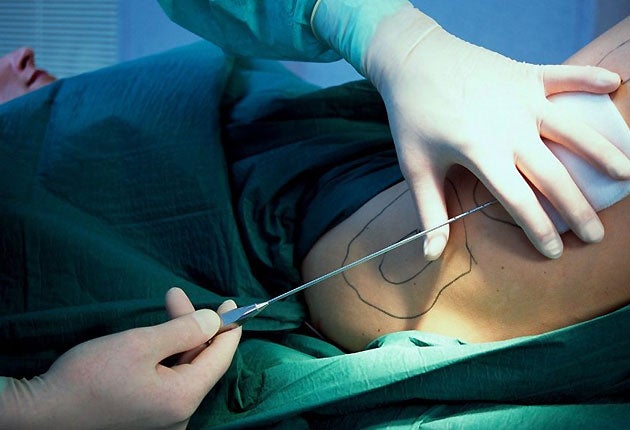'Miracle' ops for breast enlargement won't last, say surgeons
Experts deflate claims of US specialist who uses thigh fat for cosmetic enhancements

A useful adage in Harley Street, as it is in the City, is that if it looks too good to be true, it probably is. Medicine's golden mile is populated by the world's finest doctors – alongside the most accomplished quacks – but from time to time in their exuberance they allow hope to triumph over experience.
A well-known cosmetic surgery clinic's promise that women could soon look forward to an operation that gave them bigger breasts and a slimmer figure at the same time sounded like a breakthough. Media reports at the weekend said the technique was being hailed as a "two for one", because excess fat was extracted from where it was not wanted – the belly, hips or thighs – and relocated to the bust.
Mel Graham, chairman of the Harley Medical Group, was quoted as saying: "This is the most exciting breakthrough in cosmetic surgery I have seen over the last two decades. Within 10 years, breast enhancement through fat relocation will dominate the breast enlargement market."
He said the technique created breasts with a more natural shape and feel, and more than 2,500 women had registered to receive information about the £8,000 procedure – twice the cost of normal breast enlargement – which was due to become routinely available next year.
Details of the operation will be presented at the annual meeting of the British Association of Aesthetic Plastic Surgeons (BAAPS) in Cardiff this week by Sidney Coleman, a New York specialist who popularised the technique of fat transfer, mostly to the face to remove wrinkles.
Yesterday, however, rival cosmetic surgeons criticised the "hype" surrounding the new operation which they said was "premature". "[This] is setting consumers up for disappointment and there are many reasons for vigilance," said Dai Davies, of Plastic Surgery Partners in Harley Street.
Doctors had experimented with innumerable aids in their attempts to give women larger busts, Mr Davies said. Robert Gersuny started a craze for paraffin injections in Vienna in the 1890s. Other substances used since then have included ivory balls, vegetable oil, beeswax, silicon, silk fabric and even glazing putty.
The latest is Macrolane, a preparation of a naturally occurring chemical in the body called hyaluronic acid, which is injected directly into breasts. However, the most recent British study showed an 18 per cent complication rate, with all patients needing top-up injections after nine and 15 months.
Using the body's own supply of fat to enlarge breasts has a long history. The technique of removing fat by liposuction, and then injecting it into the chest has been tried for almost 20 years but with limited success, Mr Davies added.
"Where you are injecting small amounts of fat into the face, which has a good blood supply, there is good evidence that it works. Most plastic surgeons would agree there is a place for it," he explained. "But this involves injecting a large blob of fat into the breast area. Fat consists of living cells and living cells must have a blood supply, otherwise they die."
A study of 230 women who underwent fat transfer in Japan, published in Aesthetic Plastic Surgery last year, found that, on average, half the fat injected was lost and all the women needed a second procedure after a year. There are also fears that dying fat cells could cause micro-calcification in the breast leading to difficulties in breast screening and an increase in biopsies – an invasive procedure to remove tissue to check for cancer. Mr Davies said: "I don't think we should be a testing ground for all these techniques.
"You are feeding on a susceptible group of people. There should be controls but, sadly, the Government has decided it won't implement regulation."
Professor David Sharpe, a plastic surgeon in Yorkshire and the founding chairman of the breast special interest group of BAAPS, said: "This sounds like another example of creative marketing. Breast implants are a well-tried and tested method. At the moment, I would stick with that."
Mel Braham, chairman of the Harley Medical Group, said results of a US trial to be presented next month would demonstrate the success of the operation. "The results will be assessed by our medical board and, if approved, the operation will be introduced next year. I don't take risks with patients. I am confident this is a safe procedure."
Join our commenting forum
Join thought-provoking conversations, follow other Independent readers and see their replies
Comments